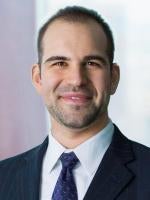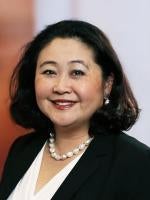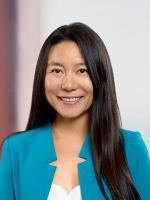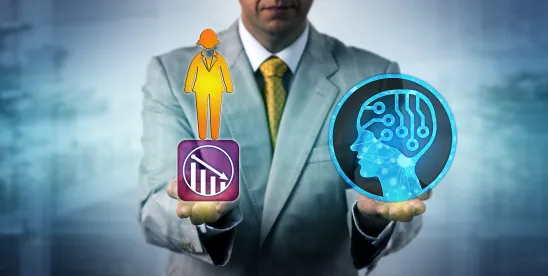The United States Patent and Trademark Office (USPTO) issued an important update to its guidance on patent subject matter eligibility under 35 U.S.C. § 101, specifically focusing on artificial intelligence (AI) and other software-related emerging technologies (ET). This article synthesizes key takeaways and insights from the update and provides implications for innovators and patent practitioners.
The USPTO update, effective July 17, 2024 and prompted by Executive Order 14110 on the “Safe, Secure, and Trustworthy Development and Use of Artificial Intelligence,” aims to refine and clarify the process for determining the patent eligibility of AI-related inventions. Notably, it provides several examples of patent eligible and ineligible claims directed to AI technology paired with detailed eligibility analysis for each. Thus, the guidance provides practitioners with more tools to evaluate patentability of an invention and to draft claims that are more likely to avoid section 101 rejections common in software-related patent applications.
Our key takeaways are as follows:
- AI claims must go beyond mere data processing steps by including additional elements that result in tangible, practical outcomes, such as enhancing the accuracy of speech recognition systems.
- Claims should emphasize how the integration of AI leads to specific technological advancements. Demonstrating that an AI model improves the functionality or performance of a system, such as reducing noise in audio processing or increasing the accuracy of image recognition, can help establish the practical utility required for patent eligibility.
- To transform abstract ideas into patent-eligible inventions, it is crucial to include additional steps that go beyond routine data processing and can be considered significant extra-solution activity. For example, synthesizing new data outputs, applying AI-generated results to subsequent processes, and integrating these into larger systems can demonstrate significant extra-solution activity.
- Claims to medical AI technology should specify particular treatments or methods to transform abstract data analysis into a patent-eligible invention. However, caution should be exercised regarding the potential complexities of divided infringement and the degree of enforceability, as explained in further detail below.
Key Clarifications in the 2024 Update
The 2024 guidance update builds upon the principles established in the 2019 guidance, emphasizing the need to evaluate claims that integrate “judicial exceptions” such as abstract ideas, laws of nature, and natural phenomena into practical applications in accordance with 2014 Supreme Court decision Alice Corp. v. CLS Bank Int’l. The critical clarifications introduced in the update are as follows:
- Detailed Analysis of Abstract Ideas: The updated guidance provides more explicit instructions for distinguishing between claims that merely involve an abstract idea and those that recite an abstract idea. This distinction is crucial for AI inventions, which often include abstract ideas such as mathematical concepts and/or methods of organizing human activity. The update includes recent case law examples to illustrate these distinctions more clearly.
- Practical Application: There is an enhanced focus on evaluating whether a claim integrates a judicial exception into a practical application. This involves assessing additional elements in the claim to determine if they impose meaningful limits on the exception, transforming the claim into patent-eligible subject matter. This step is essential in determining whether the claimed invention offers a concrete technological improvement.
- AI-Assisted Inventions: The update clarifies that the method of invention development, including the use of AI, does not impact subject matter eligibility. Instead, the focus remains on the claimed invention itself, showing that AI-assisted inventions are evaluated on equal footing with other technologies. This distinction helps to ensure that AI’s role as a tool does not exclude inventions from eligibility, provided there is significant human contribution.
- Incorporation of Recent Case Law: The guidance integrates recent Federal Circuit decisions, offering up-to-date legal standards and interpretations particularly relevant for AI inventions. This integration helps promote consistency and clarity in the application of patent eligibility criteria, reflecting the latest judicial thinking.
- New Examples: The USPTO has introduced new examples (Examples 47-49) specifically tailored to AI technologies. These examples illustrate the application of the subject matter eligibility analysis to AI-related claims, providing practical guidance:
- Example 47: Focuses on an artificial neural network designed to identify or detect anomalies, showing how claims involving specific applications of neural networks can meet the eligibility criteria by demonstrating an improvement in computer technology.
- Example 48: Pertains to AI-based methods for analyzing speech signals and separating desired speech from background noise, highlighting how claims that apply AI to solve specific technical problems in signal processing can be patent-eligible.
- Example 49: Involves a method for personalizing medical treatment using an AI model, illustrating how AI can be integrated into practical applications that provide concrete benefits in the medical field, aiding such claims in meeting the eligibility requirements.
Key Insights from the New Examples
Some of the examples and claims in the 2024 guidance update include additional takeaways and key points which we have summarized below.
Example 48: AI-Based Speech Separation
Example 48 include three example claims, one of which is deemed ineligible and the other two eligible. A comparison of Claim 1 (deemed ineligible) and Claim 2 (deemed eligible) of Example 48 provides insight on eligibility of AI-related claims.
Example 48 Overview
[Claim 1] A speech separation method comprising:
- receiving a mixed speech signal x comprising speech from multiple different sources sn, where n ∈ {1, . . . N};
- converting the mixed speech signal x into a spectrogram in a time-frequency domain using a short time Fourier transform and obtaining feature representation X, wherein X corresponds to the spectrogram of the mixed speech signal x and temporal features extracted from the mixed speech signal x; and
- using a deep neural network (DNN) to determine embedding vectors V using the formula V = fθ(X), where fθ(X) is a global function of the mixed speech signal x.
[Claim 2] The speech separation method of claim 1 further comprising:
- partitioning the embedding vectors V into clusters corresponding to the different sources sn;
- applying binary masks to the clusters to create masked clusters;
- synthesizing speech waveforms from the masked clusters, wherein each speech waveform corresponds to a different source sn;
- combining the speech waveforms to generate a mixed speech signal x' by stitching together the speech waveforms corresponding to the different sources sn, excluding the speech waveform from a target source ss such that the mixed speech signal x' includes speech waveforms from the different sources sn and excludes the speech waveform from the target source ss; and
- transmitting the mixed speech signal x' for storage to a remote location.
Subject Matter Eligibility: Claim 2 incorporates all the elements of Claim 1, which includes receiving audio input from multiple sources, separating the audio signals into distinct components, and applying mathematical algorithms to enhance the clarity of the separated audio. The 2024 guidance update says that Claim 1 is not eligible because it is directed to an abstract idea of manipulating information using mathematical techniques without any practical application. The steps in Claim 1 involve receiving, separating, and processing audio signals, which are considered data processing steps. These steps, while necessary for the method, do not add any inventive concept or practical application that transforms the abstract idea into a patent-eligible invention.
In contrast, Claim 2 specifies that the separated audio components are used in a speech recognition system to improve the accuracy of voice commands in a hands-free environment. According to the 2024 guidance update, this provides a meaningful limit and integrates the judicial exception into a practical application, making the claim patent-eligible. By specifying the use of the separated audio in a specific, practical application, Claim 2 adds a level of practical utility that is not present in Claim 1, thereby meeting the criteria for patent eligibility.
Claim 2 exemplifies how AI-related technologies can be claimed in a manner that integrates abstract ideas into practical applications, thereby transforming them into patent-eligible subject matter. The claimed additional steps beyond mere data processing aid in the claim's eligibility by demonstrating how the abstract ideas are applied to achieve a specific technical improvement in speech separation technology. This approach helps establish a framework for demonstrating the practical utility and technical benefits of AI-based inventions.
- Technical Improvement in Various Fields: Example 48 can be analogized to claims involving technical improvements in fields such as noise reduction in audio processing, image enhancement in computer vision, or data cleaning in large datasets. These improvements demonstrate the practical application of AI models to solve specific technical problems, transforming abstract ideas into valuable technological advancements. For example, Claim 1 does not bring technical improvement because it involves the mere steps of "receiving a mixed audio signal containing multiple speech signals," "applying a mathematical model to separate the mixed audio into individual speech signals," and "outputting the separated speech signals." These steps are considered routine data processing without any inventive concept or practical application that transforms the abstract idea into a patent-eligible invention. Claim 2, on the other hand, improves related technical fields because it specifies the use of the separated audio components in a real-time speech recognition system to enhance the accuracy of voice commands in hands-free environments. This additional step provides a practical application that results in tangible benefits, such as improved noise reduction in audio processing, enhanced accuracy in real-time speech recognition, and overall better performance in voice-controlled systems. By applying the separated audio signals to a practical, real-time application, Claim 2 adds a meaningful limit that is absent in Claim 1, thereby demonstrating a clear technological improvement and transforming the claim into patent-eligible subject matter.
- Practical Applications: Highlighting the real-world applications of the claimed method or system can bolster the argument for patent eligibility. Demonstrating how the abstract idea is applied in a way that provides concrete benefits or solves specific problems in the relevant field is crucial. Claim 1 does not integrate the abstract idea into a practical application because "the claim merely uses a mathematical model to manipulate data without applying the data in any specific manner that improves technology or provides a practical application." Claim 2, however, does include a practical application because it specifies the use of the separated audio components in a real-time speech recognition system to enhance the accuracy of voice commands in hands-free environments. This additional step shows how the abstract idea is transformed into a specific, practical application that provides clear benefits, such as improved accuracy in speech recognition systems, thereby meeting the criteria for patent eligibility.
- Insignificant Extra-Solution Activity: Claims that include additional elements like synthesizing speech waveforms from masked clusters and generating a mixed speech signal that excludes unwanted sources are not considered insignificant extra-solution activities. These steps result in tangible, practical outcomes, enhancing the claim's eligibility. Claim 1 is considered to involve routine data processing steps that are mere “insignificant extra-solution activity” that does not transform the abstract idea into a patent-eligible invention. Claim 2, on the other hand, includes additional steps that go beyond mere data processing by specifying the use of separated audio components in a real-time speech recognition system to enhance the accuracy of voice commands in hands-free environments. This practical application is not considered insignificant extra-solution activity because it provides a tangible outcome that directly benefits the technology by improving the accuracy and functionality of real-time speech recognition systems.
By leveraging the structure and reasoning behind Example 48, claims in various fields can be crafted to meet the criteria for patent eligibility, aiding them in providing meaningful, tangible benefits and not merely abstract ideas.
Example 49: Personalized Medical Treatment Using AI
Example 49 in the 2024 guidance update presents a method for personalizing medical treatment using an AI model. This example is particularly instructive for those developing AI-driven healthcare solutions and seeking to navigate the complexities of patent eligibility. Below we compare Claim 1 (deemed ineligible) and Claim 2 (deemed eligible).
[Claim 1]: A post-surgical fibrosis treatment method comprising:
- collecting and genotyping a sample from a glaucoma patient to provide a genotype dataset;
- identifying the glaucoma patient as at high risk of post-implantation inflammation (PI) based on a weighted polygenic risk score that is generated from informative single-nucleotide polymorphisms (SNPs) in the genotype dataset by an ezAI model that uses multiplication to weight corresponding alleles in the dataset by their effect sizes and addition to sum the weighted values to provide the score; and
- administering an appropriate treatment to the glaucoma patient at high risk of PI after microstent implant surgery.
[Claim 2]: The method of claim 1, wherein the appropriate treatment is Compound X eye drops.
Subject Matter Eligibility: Claim 2 incorporates all the elements of Claim 1, which includes collecting and genotyping a sample and identifying the patient as at high risk of PI. These steps involve judicial exceptions as they encompass abstract ideas related to data analysis and mathematical calculations. While these steps are necessary for the method, they do not, by themselves, transform the claim into patent-eligible subject matter. However, Claim 2 specifies that the treatment administered is Compound X eye drops, which provides a meaningful limit and integrates the judicial exception into a practical application, making the claim patent-eligible.
Administering Treatment Steps: Including an administering treatment step can sometimes support the argument for subject matter eligibility by grounding the claim in a tangible, real-world application. However, this step can also introduce other considerations:
- Divided Infringement Issues: If different parties perform the steps (e.g., a healthcare provider administers the treatment based on a plan generated by the AI model), proving infringement can become complex. Divided infringement occurs when multiple parties collectively perform all steps of a patented method, but no single party performs every step, complicating enforcement.
- Degree of Enforceability: The enforceability of a claim that includes an administering step depends on the ability to monitor and control the performance of that step. In a healthcare context, this could involve various stakeholders, making it challenging to enforce the patent against all potential infringers.
When drafting claims, it is essential to ensure that each step, particularly those involving administering treatments, is clearly defined and contributes to the practical application of the abstract ideas. This may help the claim meet the criteria for patent eligibility under the updated USPTO guidelines.
Implications for Innovators and Patent Practitioners
The 2024 guidance update represents a significant step toward promoting AI innovation while addressing the unique challenges posed by AI and other software-related technologies. For innovators and patent practitioners, this update provides a clearer framework for evaluating the patent eligibility of AI-related inventions, ensuring that valuable technological advancements receive appropriate patent protection.
By incorporating detailed examples and recent case law, the update aims to enhance the predictability and transparency of the patent examination process. Innovators can now better understand how to frame their claims to meet the eligibility criteria, ensuring that their AI-driven inventions are adequately protected.
In light of this update, those working with AI technologies should carefully consider how their inventions integrate abstract ideas into practical applications. Emphasizing specific technological improvements and practical applications will be crucial in securing patent protection under the updated guidelines.
For those navigating the patent application process, the 2024 guidance update provides valuable insights and tools to aid in the fair and consistent evaluation of AI-related inventions, fostering an environment that supports innovation and technological advancement in the rapidly evolving field of artificial intelligence.






 />i
/>i

